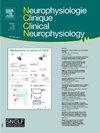肌电信号填充分析,一种针刺肌电信号评价运动单元恢复的新方法
IF 2.4
4区 医学
Q2 CLINICAL NEUROLOGY
Neurophysiologie Clinique/Clinical Neurophysiology
Pub Date : 2025-02-20
DOI:10.1016/j.neucli.2025.103059
引用次数: 0
摘要
目的观察自发性收缩增强过程中运动单位电位(MUPs)募集的进展,为了解支配肌肉的运动单位(mu)提供重要信息。在这里,我们描述了一种方法来量化肌肉内肌电图(iEMG)信号在增加力水平期间的补充水平。方法记录健康受试者胫骨前肌的同心针肌电图信号,用力从0逐渐增加到最大。通过测量EMG填充因子(FF)来分析iEMG填充过程,FF是由平均校正iEMG和均方根iEMG计算得出的。结果(1)所有参与者在低收缩力下的iEMG活动都是“离散的”(FF<0.3)。(2) 83%的参与者在最大努力时的iEMG活动为“充分”(FF>0.5),而在最大努力时的iEMG活动为“不完全减少”(0.3<FF<;0.5),为17%的参与者。(3)在荷载为20% MVC时,FF迅速增加,在较高的荷载下趋于平稳,因此FF曲线呈典型的指数型。结论iEMG填充法具有普遍适用性,因为所有健康参与者的FF都在大范围内增加。意义肌电图填充分析在神经源性疾病和运动神经元疾病中可能具有检测MU丢失和重构的潜力。本文章由计算机程序翻译,如有差异,请以英文原文为准。
EMG filling analysis, a new method for the assessment of recruitment of motor units with needle EMG
Objectives
The progression of recruitment of motor unit potentials (MUPs) during increasing voluntary contraction can provide important information about the motor units (MUs) innervating a muscle. Here, we described a method to quantitate the recruitment level of the intramuscular electromyographic (iEMG) signal during an increasing force level.
Methods
Concentric needle EMG signals were recorded from the tibialis anterior of healthy subjects as force was gradually increased from 0 to maximum force. The iEMG filling process was analyzed by measuring the EMG filling factor (FF), calculated from the mean rectified iEMG and the root mean square iEMG.
Results
(1) The iEMG activity at low contraction forces was “discrete” (FF<0.3) for all participants. (2) The iEMG activity at maximal effort was “full” (FF>0.5) for 83 % of the participants, whereas it was “incompletely-reduced” (0.3<FF< 0.5) for 17 % of the participants. (3) The FF increased rapidly for forces up to 20 % MVC, and then levelled off for higher forces: thus, the FF curve had a typical exponential shape.
Conclusions
The iEMG filling method can be considered of general applicability since the FF increased over a wide range in all healthy participants.
Significance
The EMG filling analysis may have potential to detect scenarios of MU loss and remodelling in neurogenic and motor neuron diseases.
求助全文
通过发布文献求助,成功后即可免费获取论文全文。
去求助
来源期刊
CiteScore
5.20
自引率
3.30%
发文量
55
审稿时长
60 days
期刊介绍:
Neurophysiologie Clinique / Clinical Neurophysiology (NCCN) is the official organ of the French Society of Clinical Neurophysiology (SNCLF). This journal is published 6 times a year, and is aimed at an international readership, with articles written in English. These can take the form of original research papers, comprehensive review articles, viewpoints, short communications, technical notes, editorials or letters to the Editor. The theme is the neurophysiological investigation of central or peripheral nervous system or muscle in healthy humans or patients. The journal focuses on key areas of clinical neurophysiology: electro- or magneto-encephalography, evoked potentials of all modalities, electroneuromyography, sleep, pain, posture, balance, motor control, autonomic nervous system, cognition, invasive and non-invasive neuromodulation, signal processing, bio-engineering, functional imaging.

 求助内容:
求助内容: 应助结果提醒方式:
应助结果提醒方式:


